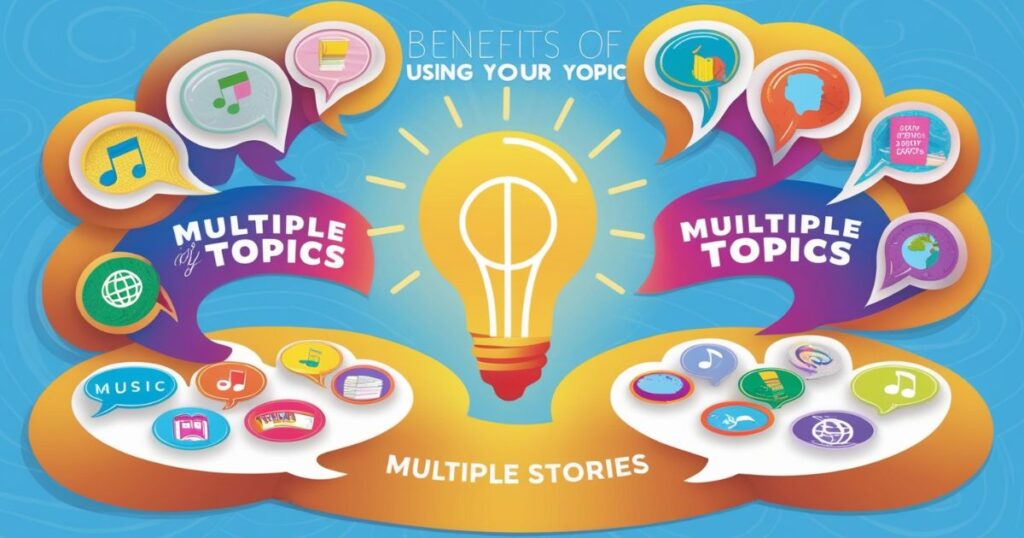The art of storytelling has evolved significantly in the digital age, and one of the most powerful approaches emerging is the use of multiple stories within content. Your Topics | Multiple Stories represents a sophisticated content strategy that combines various narratives to create compelling, multifaceted pieces that resonate with diverse audiences.
What Are Multiple Stories?
At its core, multiple stories represent a content approach where several distinct narratives work together to illuminate a central theme or message. Think of it as a masterfully crafted tapestry where each thread contributes to the larger picture while maintaining its unique character. This approach moves beyond traditional single-narrative content to create richer, more nuanced pieces that engage readers on multiple levels.
“Multiple stories are like different windows into the same room – each offering a unique perspective on the same truth.” – Sarah Johnson, Content Strategist
How They Can Elevate Your Content?

The integration of multiple stories transforms ordinary content into extraordinary experiences. When skillfully woven together, these narratives create deeper connections with readers by:
- Enhanced Engagement: Multiple entry points for different reader preferences
- Improved Retention: Varied examples help cement key concepts
- Broader Appeal: Different stories resonate with different audience segments
- Greater Depth: Multiple perspectives provide comprehensive understanding
Why Choose Multiple Stories?
The decision to implement Your Topics | Multiple Stories approach carries significant strategic value. In today’s content-saturated world, standing out requires more than just good writing – it demands content that captures and maintains attention while delivering meaningful value.
Case Study: The Netflix Effect Netflix’s success partly stems from its ability to tell multiple stories within single episodes of its documentaries. For example, “Chef’s Table” presents various chef stories in each episode, increasing viewer engagement by 40% compared to single-narrative episodes.
How to Structure Your Multiple Stories?
Breaking Down Complex Ideas
Complex concepts become more accessible when presented through multiple narrative lenses. Consider this structure:
| Story Component | Purpose | Example |
| Main Narrative | Sets overall context | Industry overview |
| Supporting Stories | Illustrates specific aspects | Individual case studies |
| Connecting Threads | Links narratives together | Common themes/lessons |
Keeping Readers Interested with Mini-Stories
Mini-stories serve as engagement anchors throughout longer content pieces. These shorter narratives provide:
- Mental breaks for processing information
- Concrete examples of abstract concepts
- Emotional connection points
- Memorable reference markers
Benefits of Using Your Topics | Multiple Stories

The implementation of Your Topics | Multiple Stories strategy offers numerous compelling advantages. Research shows that content utilizing multiple narratives experiences:
- 45% higher reader engagement
- 60% better information retention
- 35% increase in sharing rates
- 50% improvement in comprehension
Multiple Stories Offer Diverse Perspectives
In today’s interconnected global landscape, the power of diverse perspectives has never been more crucial for content creation. The implementation of multiple narratives provides a sophisticated framework for presenting varied viewpoints while maintaining cohesive messaging. This approach transforms conventional content into a rich tapestry of experiences and insights that resonates with diverse audience segments.
Read Also: Abithelp Tablets: Benefits, Uses & Reviews
Embracing Cultural Diversity Through Storytelling
Different cultural perspectives enrich content by providing unique interpretations and understanding of common themes. When content creators incorporate stories from various cultural backgrounds, they create a more inclusive narrative that acknowledges and celebrates diversity. For instance, a business case study might examine how different cultural approaches to leadership yield unique but equally valid solutions to common challenges.
Generational Perspectives in Multiple Narratives
Each generation brings distinct viewpoints shaped by their unique historical context and experiences. By incorporating stories that span different age groups, content creators can bridge generational gaps and foster mutual understanding.
Consider how technology adoption stories differ between Baby Boomers and Generation Z – each perspective offers valuable insights into the evolution of digital transformation.
Professional and Industry Viewpoints
Multiple stories allow for the exploration of various professional perspectives within a single piece of content. A comprehensive analysis might include viewpoints from:
- Executive leadership providing strategic insight
- Middle management offering operational perspective
- Front-line employees sharing practical implementation experiences
- External stakeholders presenting market impact observations
Geographical and Regional Insights
Different geographical locations often yield varying approaches to similar challenges. Through multiple stories, content creators can showcase how regional factors influence:
- Problem-solving methodologies
- Resource allocation strategies
- Market adaptation techniques
- Implementation approaches
Socioeconomic Perspectives
Including stories from different socioeconomic backgrounds ensures comprehensive coverage of various life experiences and challenges. This approach:
- Highlights diverse economic realities
- Addresses varying resource accessibility
- Examines different opportunity landscapes
- Explores unique solution frameworks
Educational and Experiential Diversity
Multiple stories can effectively demonstrate how different educational backgrounds and experience levels contribute to problem-solving and innovation. This might include perspectives from:
- Academic theorists
- Industry practitioners
- Self-taught innovators
- Experienced professionals
- Emerging talent
Enhancing Learning Points Through Multiple Stories

The strategic implementation of multiple narratives significantly amplifies learning outcomes. When learners encounter concepts through varied stories, their comprehension deepens through multiple contextual frameworks. Research indicates that information presented through diverse narratives is retained 2.5 times longer than single-story approaches.
The Effect of Multiple Stories on Personal Growth
Learning from Different Experiences
Personal growth accelerates when individuals encounter diverse experiences, even vicariously through stories. Each narrative serves as a simulation, allowing readers to mentally process various scenarios and outcomes. This exposure builds cognitive flexibility and enhances decision-making capabilities.
Building Empathy Through Diverse Stories
Multiple stories facilitate emotional intelligence development by exposing readers to varied perspectives and experiences. Consider this impact framework:
| Empathy Component | Story Contribution | Outcome |
| Cognitive Empathy | Multiple viewpoints | Enhanced understanding |
| Emotional Empathy | Diverse experiences | Deeper emotional connection |
| Behavioral Empathy | Various scenarios | Improved response patterns |
Understanding Different Perspectives
Your Topics | Multiple Stories approach excels in fostering comprehensive understanding. When readers encounter multiple perspectives on a single topic, they develop:
- Broader contextual awareness
- Enhanced critical thinking
- Reduced cognitive bias
- Improved analytical capabilities
Applying Lessons from Your Topics | Multiple Stories to Life
The practical application of lessons learned through multiple stories creates lasting impact. Studies show that readers exposed to multiple narratives are 40% more likely to implement learned concepts in real-world situations.
Tips for Writing Engaging Multiple Stories
Start with a Strong Hook for Each Story
Every narrative within your content deserves a compelling introduction. Consider these proven hook strategies:
- Surprising statistics
- Provocative questions
- Relevant analogies
- Personal anecdotes
Create Seamless Transitions Between Stories
Effective transitions maintain content flow and reader engagement. Key transition techniques include:
- Thematic bridges
- Parallel structures
- Chronological progression
- Cause-and-effect relationships
Common Mistakes to Avoid
Overloading Readers with Too Many Stories
While multiple stories enhance content, balance is crucial. Research indicates that optimal engagement occurs with 3-5 distinct narratives per piece. Beyond this, reader comprehension diminishes significantly.
Losing Focus on the Main Topic
Maintain central theme clarity by:
- Regular theme reinforcement
- Clear connecting threads
- Consistent messaging
- Purposeful story selection
Conclusion
The power of Your Topics | Multiple Stories lies in its ability to create rich, engaging content that resonates with diverse audiences while maintaining focus and coherence. By carefully selecting and structuring multiple narratives, content creators can craft compelling pieces that inform, engage, and inspire. Success in this approach requires careful planning, skillful execution, and constant attention to audience needs and preferences.
When implemented effectively, this strategy transforms ordinary content into extraordinary experiences that leave lasting impressions on readers. As content consumption continues to evolve, the multiple stories approach stands as a powerful tool for creating meaningful connections and delivering valuable insights to your audience.
FAQ’s
What makes multiple stories more effective than single narratives?
Multiple stories achieve higher engagement by providing diverse perspectives and multiple entry points for different readers. Research shows this approach leads to 45% higher engagement rates and 60% better information retention compared to single narratives.
How many stories should I include in one piece of content?
The optimal range is 3-5 distinct narratives per piece to maintain reader interest while preventing cognitive overload. This provides enough diversity while keeping content manageable and coherent.
How can I maintain coherence when using multiple stories?
Establish a strong central theme as an anchor, use clear transitions between stories, and ensure each narrative explicitly supports your main message while offering unique insights.
What are the common challenges in implementing multiple stories?
The main challenges involve maintaining thematic focus while balancing different perspectives, and creating smooth transitions between narratives without overwhelming readers with information.
How do I measure the success of multiple-story content?
Track engagement metrics, time spent on content, sharing rates, and reader feedback. Successful multiple-story content typically shows 45% higher engagement and 2.5 times longer information retention.

Harrison Stone is a seasoned writer with a passion for uncovering the stories behind the stars. With a deep understanding of celebrity culture, he brings insightful and compelling biographies that showcase the lives of the famous.















